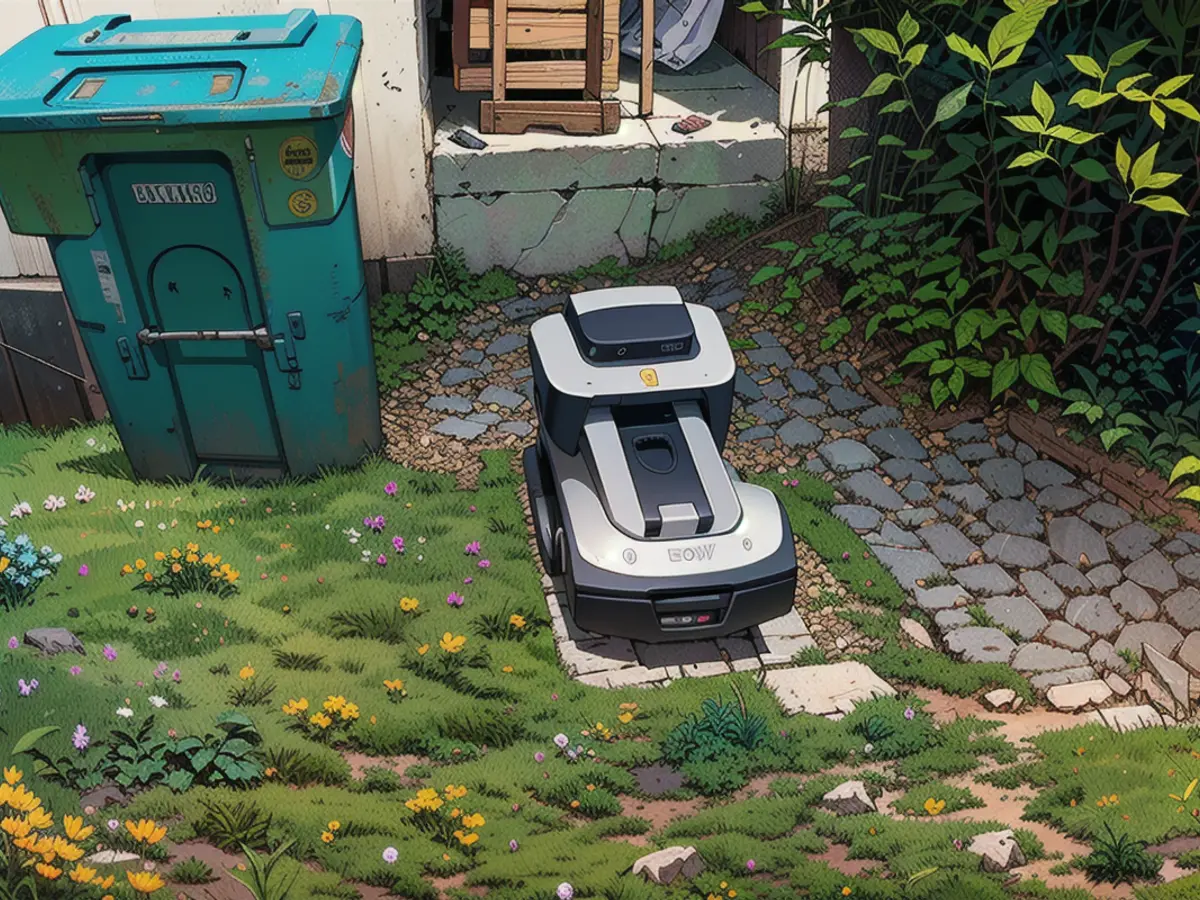Robot Lawn Mower Fails to Please in All Aspects
Discovering the intricacies of robot lawn mowers: The significance of map mapping. Initially, these lawn mowers employed subterranean wire to establish the border that the robots were prohibited from crossing. Then, RTK (which denotes "Real Time Kinematic positioning"—essentially, GPS combined with extra local data) allowed people to lay out the boundary without a wire by just walking the robot along the yard's perimeter throughout setup, as long as the robot was visible to the RTK tower. Ecovacs has attempted something new with the GOAT GX-600 ($999): The device relies on LiDAR to determine where to mow and not mow (just like robot vacuums do).
However, this method fails. The GOAT encountered trouble with various lawn arrangements I tested. It regularly failed to map the entire lawn, often mowed the same area back and forth numerous times instead of moving on to a new area, disregarded borders such as sidewalks, and hesitated to cross boundaries it should cross, like walks. Furthermore, the GOAT got trapped so frequently—even on flat, neatly mown grass—that it was difficult to imagine trusting it enough for it to operate independently, which is its primary purpose.
On the bright side, it's featherweight
The GOAT GX-600 is actually the third rendition of the GOAT, and while the v1 and v2 models seem to have enjoyed greater success according to prior reviews, neither appear to be accessible anymore. In favor of the GX-600, it was the most facile robot lawnmower to assemble of any I've tested. The entire charging base arrived completely assembled, as did the robot. There are no extra components, wires, or RTK towers—all you do is attach it and send the robot to investigate your lawn. Both the base and the robot were sufficiently light to shift around (which I did often).
Bother with connectivity
Connecting the GOAT to the application took a few attempts, but it was still simple enough. In general, lawn mower applications offer a multitude of settings that you can modify whether the mower is online or not. Ecovacs app has a unique attribute where you can only modify these settings when the mower is online. Upon achieving that connection, you can interact with the device over Bluetooth or Wi-Fi, but some operations necessitate Bluetooth. Most of the settings you alter on the device itself, like adjusting the mowing height. You can configure schedules and choose between the automated and manual modes via the app. The manual mode is genuinely remote control, which is more prevalent in other applications. I frequently encountered trouble connecting via Bluetooth to the robot, even when only 10 feet apart, and it's crucial for the manual mode. I had to use manual mode extremely often to guide the robot out of regions where it was having difficulty, and connecting and maintaining that connection was troublesome.
Choosey to the point of being odd

The Ecovacs GOAT insisted on mowing this individual strip over and over, for twenty minutes but never got the rest of the lawn. Credit: Amanda Blum
The majority of robot lawn mowers profess compatibility with most lawns, hindered solely by size and incline. The GOAT's mapping approaches it differently. Ecovacs has a pre-purchase assessment to help you ascertain whether the GOAT is suitable for your specific lawn. Your lawn must be bounded by a physical barrier, such as a fence or a sidewalk. Furthermore, it must be adjacent except for one walkway spanning less than 1m (three feet). Any inner "islands," such as planters or raised beds, or other obstacles like garden furniture, must be encircled by a physical barrier that the robot can detect.
Faulty hyped characteristics
The Ecovacs GOAT insisted on mowing the same narrow strip continuously for almost twenty minutes, but could not mow the remaining portion of the lawn. (Amanda Blum)The GOAT promised to mow this particular stretch repeatedly, continuously for nearly twenty minutes, but did not mow the remaining portion of the lawn. It was created for grassy tracts with no obstructions, fitted within a boundary by either a fence or a sidewalk, with only a single walkway crosswise. The GOAT never completed a single mowing cycle on this lawn. Instead of mowing the entire expanse, it rotated around the same strip, back and forth, for almost twenty minutes, and then moved forward only slightly, meaning it was still mowing the same strip of lawn. After an hour, it hadn't mowed half the grass, and eventually, it halted on a sidewalk. Since a sidewalk is supposed to be a boundary that the bot will acknowledge, I was astonished it even ventured onto it, rendering it a tripping hazard and a potential keyword for theft. Concurrently, it refused to cross the 24-inch walkway, which was far below the three-foot limit.
During a slowly progressing exchange with customer support over a few days, they initially informed me that the robot could only pass through a threshold that was less than three feet wide. Upon pointing out this fact, they later claimed the robot couldn't cross any threshold, suggesting I pick it up and place it on the other side of the grass before sending it out to mow. This technique also failed - the mower issued an error message stating it had left the mappable area, and lifting the mower necessitated re-entering the pin on the robot. The robot also hindered its return to the dock in most instances. Even when the dock was precisely positioned as recommended by support, it only returned to the dock approximately 60% of the time. In spite of this, I persisted in sending the robot out every day for a week to see if the issues would resolve before abandoning it.
On a perfectly level lawn, which had been mowed just before our arrival, the GOAT became trapped. Credit: Amanda Blum
A Disappointment on an Immaculate Lawn

Even on a perfectly flat lawn, that had just been mowed, the GOAT got stuck. Credit: Amanda Blum
In an effort to examine the performance of the GOAT on a lawn that was well-groomed, I decided to test it on a medium-sized backyard with a flat surface, devoid of islands, and completely enclosed by fencing. It was also flawlessly manicured. I intended to observe whether the GOAT would complete a single run without encountering problems. Despite the perfectly flat terrain, the robot experienced repeated blade jams, causing the robot to halt and relay an error message. Disregarding these notifications from the app, I instructed the mower to continue each time, but it could only advance a few inches before halting once more due to the recurring errors. I even moved the robot to a different area within the lawn, but this to no avail. At the very least, the robot did manage to return to the dock when this particular lawn was tested.
On my final try - on a tiny, fenced lawn measuring 30x15 feet - we encountered more of the same issues. The GOAT encountered difficulties moving at the perimeter, and when it commenced mowing the center, it skipped vast expanses of the grassy area and frequently notified me of errors.
While their vacuums are reputable, I've never before had such a disastrous experience with an Ecovac product. The GOAT has failed to accurately designate a bounday for me, or to mow the entirety of a designated area. Additionally, it's unreliable in returning to its docking point, crossed boundaries it shouldn't have (for example, onto walkways), and couldn't navigate a completely flat piece of terrain without encountering frequent errors.
Lacking Key Features of Robot Lawn Mowers
Although I'd be open to testing a different GOAT iteration, I believe it's unnecessary to mention the pricing ($999) at this juncture. This is a mid to low price point for most lawn robots. However, acknowledging the defects of this specific GOAT, there are missing traits in this robot that are integral components of other models. These include the capacity to customize the mowing pattern, multi-zone assistance, the ability to visualize the robot's location on a map, and the capacity to see which areas of the map have and haven't been mowed. The distinction between a dwelling robot vacuum and a lawn-mowing robot is significant. A vacuum trapped in a room has potential to cause minimal damage. Meanwhile, a lawn robot with a possibly faulty mapping system can pose a hazard and become susceptible to theft. Despite this, I trust robots that enable one to set a designated area and adhere to it, like the Mammotion Luba 2 for spacious lawns with steep inclines or rough terrain. For those with narrower, more intricate lawns or delicate areas, the Segway Navimow is more reliable.

Read also:
The Ecovacs Goat GX-600, despite its lightweight design, encounters significant challenges in mapping and mowing the lawn effectively. Despite using LiDAR technology similar to robot vacuums, it frequently fails to map the entire lawn, mows the same area repeatedly, disregards boundaries like sidewalks, and struggles to cross boundaries it should.
In the realm of tech reviews, our Ecovacs Goat GX-600 review highlights its struggles with mapping and mowing, contrasting its performance with other robot lawn mowers that have been more successful in navigating various lawn arrangements.








